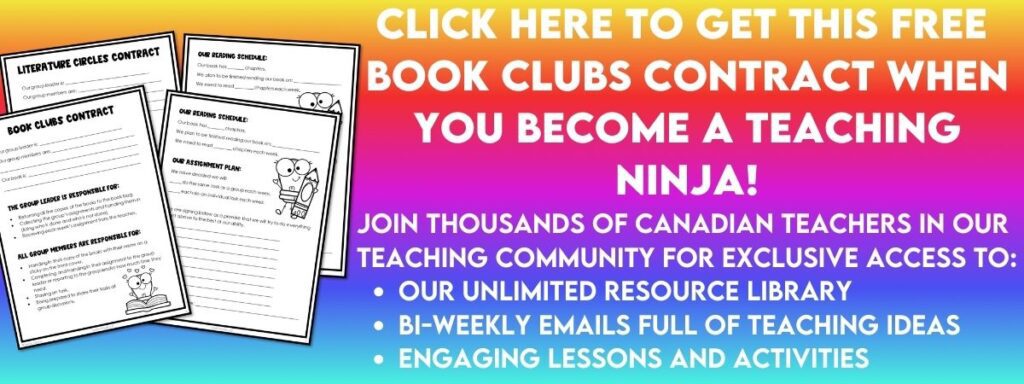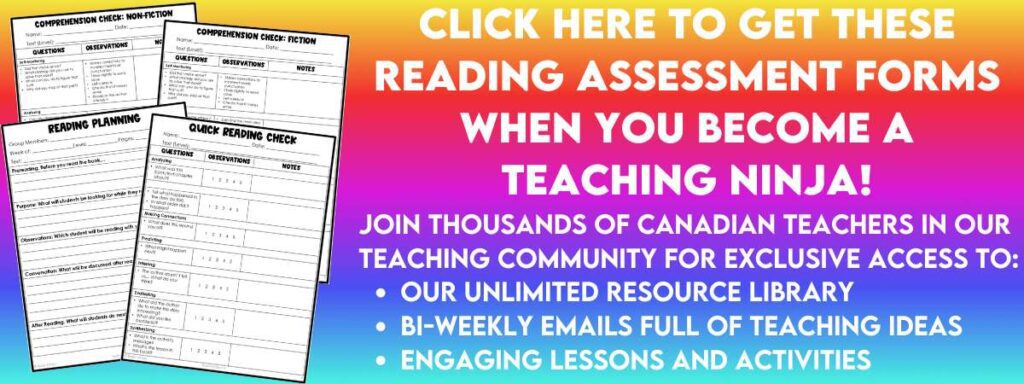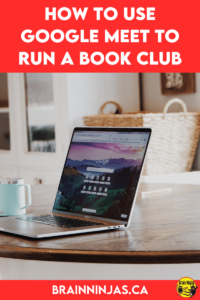
Are you looking for a twist on a Book Club to help spice up your reading instruction? Using Google Meet can be just the twist you need to get students reading, writing and talking about books. If you’re teaching reading, you need to give this a shot!
The point of book clubs is to have students (or people) read the same book together and then discuss the book. It is not about reading a book and then doing comprehension questions. No one wants to do that (or mark that). It’s about fostering a love of reading for life.
Why Google Meet?
First of all, despite using Google Meet to run your book clubs, you are still going to do the set up the old-fashioned way. So, why would you even want to use Google Meet? What’s the benefit?
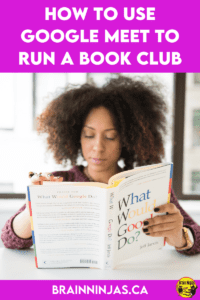
Our students loved it. The engagement was through the roof. That really was the best reason for us, but it wasn’t the reason why we tried it in the first place. Now, this was before the pandemic. Since we’ve been online teaching, students have continued to use Google Meet for their book clubs, but there’s a little less enthusiasm.
We had several students that needed skills talking about books. They seem to read fine, but they don’t understand how to talk about what they’ve read. We model this all the time with our read alouds, but in a whole-class setting, this doesn’t always give students the opportunity to participate.
With traditional novel studies, students read a book and then answer questions about it, but they don’t talk to each other about the book. That is a skill our students needed and were missing. We also didn’t want to kill the love of reading with all kinds of writing tasks. Using Google Meet gave students the opportunity to answer questions with videos. It put everyone on an equal playing field.
How to Set Up Book Clubs
If you are new to Book Clubs, you might like our post How to Teach Reading With Book Clubs.
Gather Your Materials
You will need one copy of a novel per student. This can be an actual novel or you can choose to use an ebook or audiobook. It depends on what your students need. You also need to have extra copies and titles so students will have a bit of choice.
We use Google Classroom regularly in our classroom, which helped when we had to move to online learning. If Google Classroom is new to you, try this post. If technology is new to your students, start here.
Block Out the Time
Decide how long students will have to read (and then add a week or two) their books. Make sure you leave a cushion so that students who are slower readers will have enough time. Think about all the times in your school day when students will have time to read their books. We start every morning with 15-20 minutes of silent reading, but we also read for five to ten minutes after every break in the day like lunch or recess. Set a deadline for the book clubs.
Book Talk the Titles
Tell your class about the different books that are available. This means getting them excited to read them. If you aren’t sure what to say because you haven’t had time to read the book, try checking out GoodReads.com. There are lots of summaries and reviews written by real people so you can usually find some information about a book.
One of our favourite book talks described a book as: a tween girl gets in a fight at school on the first day, gets her best friend drunk and falls off a roof at a party. Any guesses? The answer is at the end of this post.
Host a Book Tasting

Let your students look at the possible books. Ask them to read the cover and the first page to see if they like the book. Teach students not to judge a book by its cover. At the end of the tasting ask students to tell you their first, second and third choices for which book they’d like to read. We usually collect the choices on index cards.
Choice for students is a good thing. Students who have the opportunity to choose aspects of their day are more likely to be engaged. And, if students don’t like the book you can always say, “Well, you picked the book so now you know this type of book doesn’t interest you.” All kidding aside, let your students choose things when it’s possible. Check out our post Why You Should Give Students Choices to understand why.
Assign Your Groups and Their Books
You know your students best, so you need to make sure your students can actually read the book. If you aren’t sure the level of your books, try using Scholastic’s Book Wizard to help you get the book leveled. When you are assigning groups consider personalities of students, reading levels and student choice.
You should know your students’ reading levels (or at least having a basic point of starting), but if you aren’t exactly sure because it’s early in the year and you haven’t had a chance to assess them, have a student read a page or two of the book you think you want to give them. They can just read quietly to you in a corner of the room while everyone is busy looking at the books. Always aim for independent reading level.
Have Your Students Meet to Sign the Contract
Yes, a contract. It is the agreement your students make with you that they will actually read the book. You can get a copy of contract you can use from our Resource Library. Members of our email list get unlimited access. Students will decide many pages they will need to read to make the deadline you’ve set. It also makes the expectations clear to students.
Set Up the Google Meet
Make one meet per group. Make sure it includes you in the group so students will know you can see everything in the chat. Name each group with the name of the novel they’re reading to help you keep track.
Talk to Your Students About the Expectations
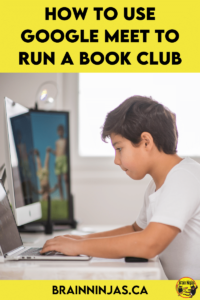
Explain to your students what you expect them to be doing during reading time, during discussion time and while they are using devices to answer the discussion questions. Be clear that students are to use the technology responsibly as intended for the assignment.
How to Run the Book Clubs with Google Meet
Generally, the daily or weekly routine would be:
- Students will read the section of the book. They will usually do this independently, but if students are doing an audiobook more than one student can be reading or listening at the same time. This will be the number of chapters the group has agreed upon.
- They will login to the Google Meet to answer the discussion questions. Students can answer by typing or by recording a short video instead of typing.
- Students can also ask their group members questions about the book. At first the teacher will add the questions for students, but as students get better at the discussion, they can start to ask their own questions.
- As the book continues encourage students to reply and discuss each others answers to the discussion questions. This will start to be a real discussion with thoughts going back and forth.
The Purpose of Book Clubs
The purpose of book clubs is to encourage discussion-not to be a writing assignment to prove a student has read what you’ve assigned. You want the conversations to be authentic, so we tailor our questions to try to help that along.
Here are some of the best questions we use:
- what do you think will happen next?
- who do you think is the most interesting character and why?
- which character is the most like you?
- why is the setting important in this book?
- which character do you think you’d like to have in our class? why?
- which GIF do you think best describes the chapter? Explain it.
- post a picture to show what you think will happen next?
- find one word from the chapter and then explain its meaning to the group (including how it was used in the book)
This isn’t for you. No worries! We also do more traditional Literature Circles in our classroom. It just depends on the students we have each year.
You should check out our post: Teaching Reading: Twisted Literature Circles. And if you’d rather skip to the activity try Twisted Literature Circles directly from our TpT Store ($USD) or our BN Shop ($CAN). It is a more traditional twist on written assignments you can give your students.
How to Assess the Book Clubs
Short Answer: We don’t.
Long Answer: We read with our students to check for fluency, understanding and their general reading skills. Even though students are reading the book independently, we still use this as an opportunity to help students develop their reading skills (not just decoding).
We look at the questions and answers in the Google Meet to see what students know and understand about the books. This is why it is so important to be part of each Google Hangout. You can be a lurker (except to post your questions) and see all kinds of things to learn about your students. How is their sentence structure, spelling, writing, expression or comprehension?
We do not mark the reading as “book club” or the projects/questions or end result. We just include this book as one of the many we read throughout the year in our Guided Reading program.
Comprehension is checked using a Guided Reading Comprehension Check. It can be found in our Resource Library or we can send a copy directly to your inbox when you join our email list. It is a great way to see if your readers are on track.
What Have Students Said About Google Meet Book Clubs?
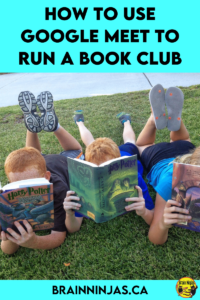
We have done this over a few different years with different students. Some of the Google Meets are still running. As in-our students just took it upon themselves to keep reading books together. The longest Meet is three years old and even though none of those students are at the same school, they still talk about books at least once a month. It used to be a hangout. How do we know? We’re still on the Meet too!
Google Meet Book Club was my favourite part of the year and I don’t usually even like reading!
Leo Age 10
Our students became SO good at asking great questions about books. They learned to agree or disagree responsibly and respectfully. This transfers directly into how people use social media. That was a bit of an unexpected find.
I like that I can answer in words, emojis or videos or GIFs. I like to have choices.
Tianna Age 10
One of the best parts-we had one student who had an unfortunate accident on a ski hill and needed to stay home for three weeks of his recovery. He didn’t miss a day of book clubs because he could work on it from home.
The book was Anne of Green Gables. We were choosing a new read aloud and it was a clear winner. Even though it’s a classic, our students loved it. This just shows that teachers can sell anything to students as long as they show passion about it.
Are you looking for other Language Arts ideas?
- How to Celebrate Poem in Your Pocket Day
- Strategies for Reluctant Readers
- Help! I Don’t Know How to Do Guided Reading
- Help! What Do the Other Kids Do During Guided Reading?
- Preparing For Guided Reading Groups
- How to Run Your Guided Reading Instruction
- Add Great Content to Your Literacy Lessons
- How to Set Up Your Reading Comprehension Schedule
- Challenge Your Students with Writing Activities Every Day
- 22 Amazing Ways to Use Word Wall Words
- How to Include Different Types of Writing in Your Classroom
So, what are your thoughts about using Google Meet to run a book club? Have you tried this? Have you tried book clubs without the extra technology challenge? Let us know in the comments below.

